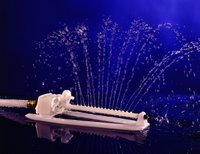For example, several retailers are looking to eliminate logistics costs by using kiosks to sell DVDs. Using a server that can store thousands of movies, consumers can simply use the kiosk to select the movie of their choice and have it burned on the spot for a fee. The use of the kiosk can a
 lso free up aisles of shelf space that are used to store the discs and can eliminate the need for reverse logistics when it comes to returning DVDs that don't sell. Something like 80 percent of DVD sales are from the first two weeks of availability. The same application could be used for music, video games, audio books and even printed books.
lso free up aisles of shelf space that are used to store the discs and can eliminate the need for reverse logistics when it comes to returning DVDs that don't sell. Something like 80 percent of DVD sales are from the first two weeks of availability. The same application could be used for music, video games, audio books and even printed books.
Stereolithography can take this idea even a step further. Stereolithography also known as 3D printing, allows users to create solid, plastic, three-dimensional objects in a matter of hours. While a stereolithography machine costs thousands of dollars right now, what if a company could create a consumer model that you can hook up to you PC like a printer, but instead of printing a receipt you could actually produce a usable and tangible 3D product, such as a vase or a lawn sprinkler like the photo to the right. Think about the implications for logistics. While this is very pie in the sky the technology is available today and with increasingly demanding consumers, it may not be that far off.



No comments:
Post a Comment